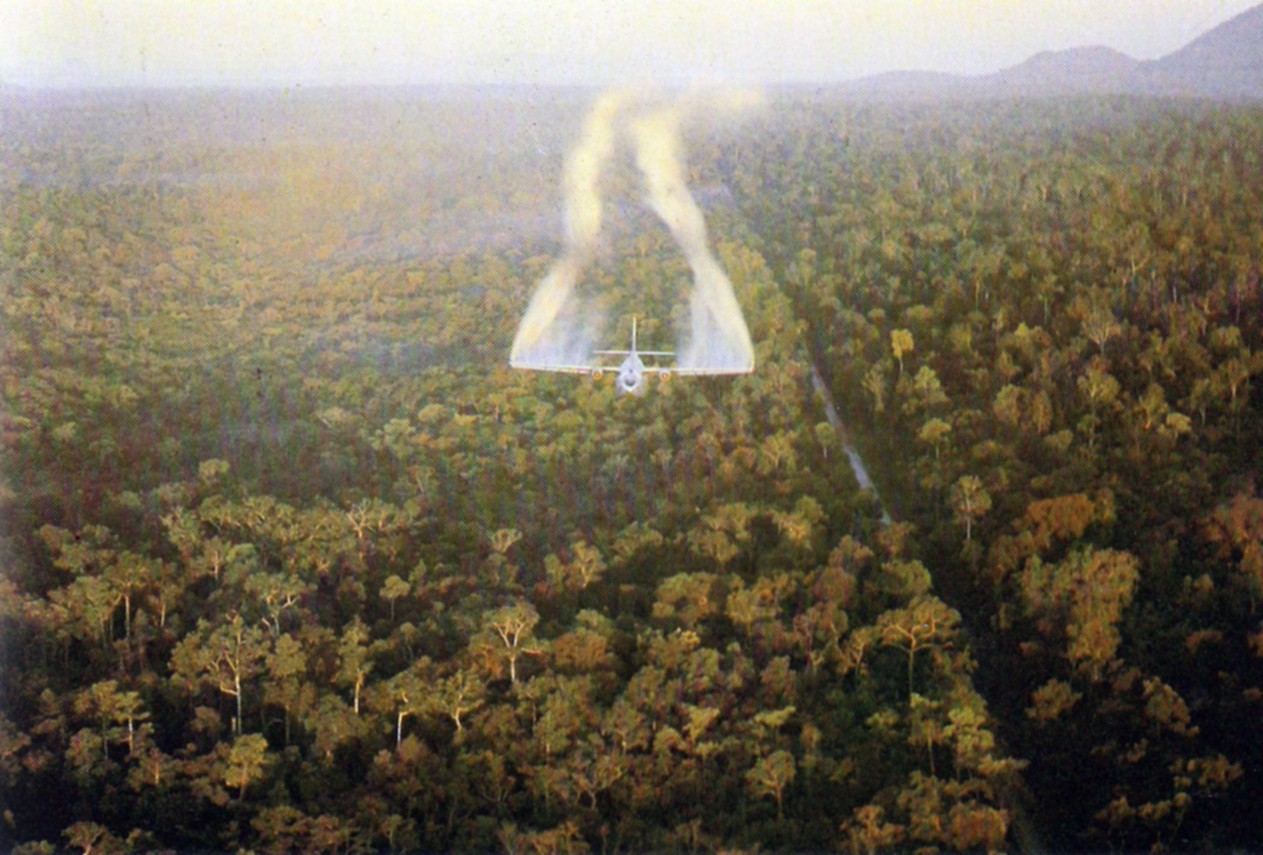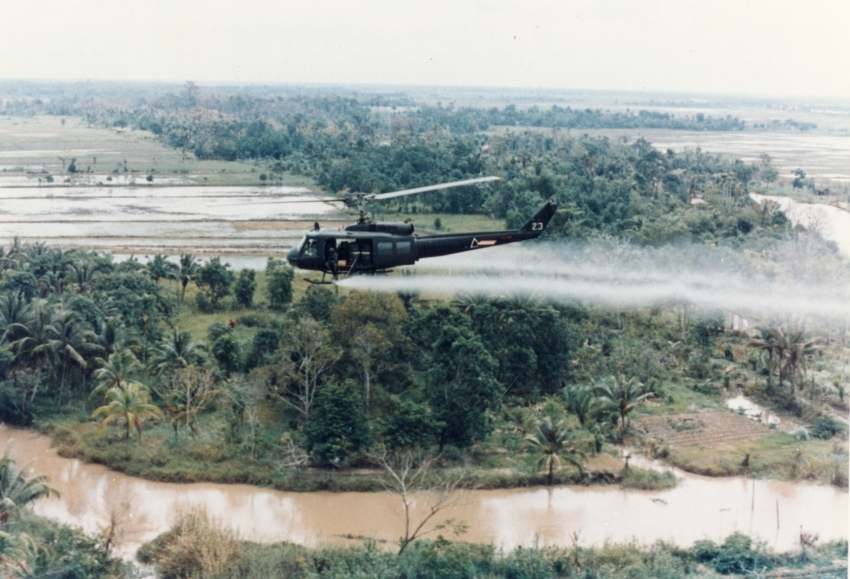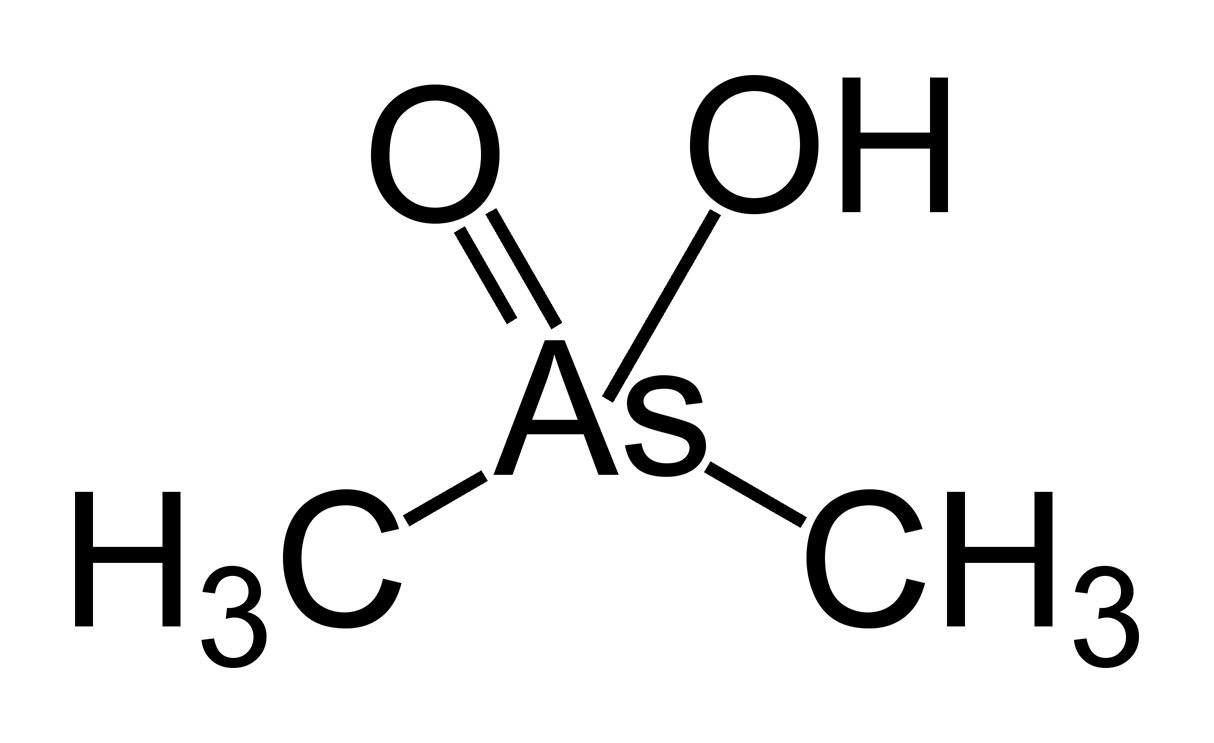|
Rainbow Herbicides
The Rainbow Herbicides are a group of tactical-use chemical weapons used by the United States military in Southeast Asia during the Vietnam War. Success with Project AGILE field tests in 1961 with herbicides in South Vietnam was inspired by the British use of herbicides and defoliants during the Malayan Emergency in the 1950s, which led to the formal herbicidal program Trail Dust (see Operation Ranch Hand). Herbicidal warfare is the use of substances primarily designed to destroy the plant-based ecosystem of an agricultural food production area and/or to destroy dense foliage which provides the enemy with natural tactical cover. Background The United States discovered 2,4-dichlorophenoxyacetic acid (2,4-D) during World War II. It was recognized as toxic and was combined with large amounts of water or oil to function as a weed-killer. Army experiments with the chemical eventually led to the discovery that 2,4-D combined with 2,4,5-trichlorophenoxyacetic acid (2,4,5-T) yie ... [...More Info...] [...Related Items...] OR: [Wikipedia] [Google] [Baidu] |
United States Air Force
The United States Air Force (USAF) is the Air force, air service branch of the United States Department of Defense. It is one of the six United States Armed Forces and one of the eight uniformed services of the United States. Tracing its origins to 1 August 1907, as a part of the United States Army Signal Corps, the USAF was established by transfer of personnel from the Army Air Forces with the enactment of the National Security Act of 1947. It is the second youngest branch of the United States Armed Forces and the fourth in United States order of precedence, order of precedence. The United States Air Force articulates its core missions as air supremacy, intelligence, surveillance, target acquisition, and reconnaissance, global integrated intelligence, surveillance and reconnaissance, airlift, rapid global mobility, Strategic bombing, global strike, and command and control. The United States Department of the Air Force, Department of the Air Force, which serves as the USAF's ... [...More Info...] [...Related Items...] OR: [Wikipedia] [Google] [Baidu] |
Agent Green
Agent Green is the code name for a powerful herbicide and defoliant used by the U.S. military in its herbicidal warfare program during the Vietnam War. The name comes from the green stripe painted on the barrels to identify the contents. Largely inspired by the British use of herbicides and defoliants during the Malayan Emergency, it was one of the so-called "Rainbow Herbicides". Agent Green was only used between 1962 and 1964, during the early "testing" stages of the spraying program. Agent Green was mixed with Agent Pink and used for crop destruction. A total of 20,000 gallons of Agent Green were procured. Agent Green's only active ingredient was 2,4,5-trichlorophenoxyacetic acid (2,4,5-T), one of the common phenoxy herbicides of the era. Even prior to Operation Ranch Hand (1962-1971) it was known [...More Info...] [...Related Items...] OR: [Wikipedia] [Google] [Baidu] |
2,2,4-Trimethylpentane
2,2,4-Trimethylpentane, also known as isooctane or iso-octane, is an organic compound with the formula (CH3)3CCH2CH(CH3)2. It is one of several isomers of octane (C8H18). This particular isomer is the standard 100 point on the octane rating scale (the zero point is ''n''-heptane). It is an important component of gasoline, frequently used in relatively large proportions (around 10%) to increase the knock resistance of fuel. Strictly speaking, if the standard meaning of ‘iso’ is followed, the name ''isooctane'' should be reserved for the isomer 2-methylheptane. However, 2,2,4-trimethylpentane is by far the most important isomer of octane and historically it has been assigned this name. Production Isooctane is produced on a massive scale in the petroleum industry by alkylation of isobutene with isobutane. This process is conducted in alkylation units in the presence of acid catalysts. : It can also be produced from isobutylene by dimerization using an Amberlyst cataly ... [...More Info...] [...Related Items...] OR: [Wikipedia] [Google] [Baidu] |
Agent Orange
Agent Orange is a chemical herbicide and defoliant, one of the tactical uses of Rainbow Herbicides. It was used by the U.S. military as part of its herbicidal warfare program, Operation Ranch Hand, during the Vietnam War from 1962 to 1971. The U.S. was strongly influenced by the British who used Agent Orange during the Malayan Emergency. It is a mixture of equal parts of two herbicides, 2,4,5-Trichlorophenoxyacetic acid, 2,4,5-T and 2,4-Dichlorophenoxyacetic acid, 2,4-D. Agent Orange was produced in the United States beginning in the late 1940s and was used in industrial agriculture, and was also sprayed along railroads and power lines to control undergrowth in forests. During the Vietnam War, the U.S. military procured over , consisting of a fifty-fifty mixture of 2,4-D and dioxin-contaminated 2,4,5-T. Nine chemical companies produced it: Dow Chemical Company, Monsanto Company, Diamond Shamrock, Diamond Shamrock Corporation, Hercules Inc., Thompson Hayward Chemical Co., Unit ... [...More Info...] [...Related Items...] OR: [Wikipedia] [Google] [Baidu] |
Picloram
Picloram is a systemic herbicide used for general woody plant control. It also controls a wide range of broad-leaved weeds, but most grasses are resistant. Pesticide Management Education Program, . A chlorinated derivative of picolinic acid, picloram is in the family of herbicides. Picloram can be sprayed on foliage, injected into plants, applied to cut surfaces, or placed at ... [...More Info...] [...Related Items...] OR: [Wikipedia] [Google] [Baidu] |
Salt (chemistry)
In chemistry, a salt or ionic compound is a chemical compound consisting of an assembly of positively charged ions ( cations) and negatively charged ions ( anions), which results in a compound with no net electric charge (electrically neutral). The constituent ions are held together by electrostatic forces termed ionic bonds. The component ions in a salt can be either inorganic, such as chloride (Cl−), or organic, such as acetate (). Each ion can be either monatomic, such as sodium (Na+) and chloride (Cl−) in sodium chloride, or polyatomic, such as ammonium () and carbonate () ions in ammonium carbonate. Salts containing basic ions hydroxide (OH−) or oxide (O2−) are classified as bases, such as sodium hydroxide and potassium oxide. Individual ions within a salt usually have multiple near neighbours, so they are not considered to be part of molecules, but instead part of a continuous three-dimensional network. Salts usually form crystalline structures ... [...More Info...] [...Related Items...] OR: [Wikipedia] [Google] [Baidu] |
Triisopropanolamine
Triisopropanolamine is an amine used for a variety of industrial applications including as an emulsifier, stabilizer, and chemical intermediate. It is also used to neutralize acidic components of some herbicides Herbicides (, ), also commonly known as weed killers, are substances used to control undesired plants, also known as weeds.EPA. February 201Pesticides Industry. Sales and Usage 2006 and 2007: Market Estimates. Summary in press releasMain page f .... See also * 1-Amino-2-propanol * Diisopropanolamine References Tertiary amines Secondary alcohols {{amine-stub ... [...More Info...] [...Related Items...] OR: [Wikipedia] [Google] [Baidu] |
Agent White
Agent White is the code name for a herbicide used by the U.S. military in its herbicidal warfare program during the Vietnam War. The name comes from the regulatory requirements of identifying each container of the various herbicides through the addition of colored stripes. The colors used were orange, purple, pink, blue, and white by the manufacturers to ensure that the contents were easily identifiable during shipment and usage, as the colors were selected by the U.S. government. Largely inspired by the British use of herbicides and defoliants during the Malayan Emergency, it was one of the so-called "rainbow herbicides". Agent White is a 4:1 mixture of 2,4-D and picloram. Agent White did not contain dioxin, which was a contaminant in some herbicide mixtures. Agent White was a proprietary product of the Dow Chemical Company. Agent White was often used when Agent Orange was not available, including for several months after the use of Agent Orange was halted in April 1970. ... [...More Info...] [...Related Items...] OR: [Wikipedia] [Google] [Baidu] |
Sodium Cacodylate
Cacodylic acid is an organoarsenic compound with the formula (CH3)2 AsO2H. With the formula R2As(O)OH, it is the simplest of the arsinic acids. It is a colorless solid that is soluble in water. Neutralization of cacodylic acid with base gives cacodylate salts, e.g. sodium cacodylate. They are potent herbicides. Cacodylic acid/sodium cacodylate is a buffering agent in the preparation and fixation of biological samples for electron microscopy and in protein crystallography. History In the 18th century it was found that combining arsenic trioxide () and four equivalents of potassium acetate () gives a product called " Cadet's fuming liquid" which contains cacodyl oxide, and cacodyl, . Early research into "cacodyls" was reported by Robert Bunsen at the University of Marburg. Bunsen said of the compounds, "The smell of this body produces instantaneous tingling of the hands and feet, and even giddiness and insensibility... It is remarkable that when one is exposed to the sme ... [...More Info...] [...Related Items...] OR: [Wikipedia] [Google] [Baidu] |
Arsenic
Arsenic is a chemical element; it has Symbol (chemistry), symbol As and atomic number 33. It is a metalloid and one of the pnictogens, and therefore shares many properties with its group 15 neighbors phosphorus and antimony. Arsenic is notoriously toxic. It occurs naturally in many minerals, usually in combination with sulfur and metals, but also as a pure elemental crystal. It has various Allotropes of arsenic, allotropes, but only the grey form, which has a metallic appearance, is important to industry. The primary use of arsenic is in alloys of lead (for example, in car batteries and ammunition). Arsenic is also a common n-type dopant in semiconductor electronic devices, and a component of the III–V compound semiconductor gallium arsenide. Arsenic and its compounds, especially the trioxide, are used in the production of pesticides, treated wood products, herbicides, and insecticides. These applications are declining with the increasing recognition of the persistent tox ... [...More Info...] [...Related Items...] OR: [Wikipedia] [Google] [Baidu] |
Agent Blue
Agent Blue is one of the " rainbow herbicides" that is known for use by the United States during the Vietnam War. It contained a mixture of dimethylarsinic acid (also known as cacodylic acid) and its related salt, sodium cacodylate, and water. History Largely inspired by the British use of herbicides and defoliants during the Malayan Emergency, killing rice was a military strategy from the very start of U.S. military involvement in Vietnam. At first, U.S. soldiers attempted to blow up rice paddies and rice stocks, using mortars and hand grenades. But grains of rice were far more durable than they understood, and were not easily destroyed. Every grain that survived was a seed to be collected and planted again. A 1967 report to the International War Crimes Tribunal stated that "The soldiers discovered that rice is one of the most maddeningly difficult substances to destroy; using thermite metal grenades it is almost impossible to make it burn and, even if one succeeds in scatteri ... [...More Info...] [...Related Items...] OR: [Wikipedia] [Google] [Baidu] |






